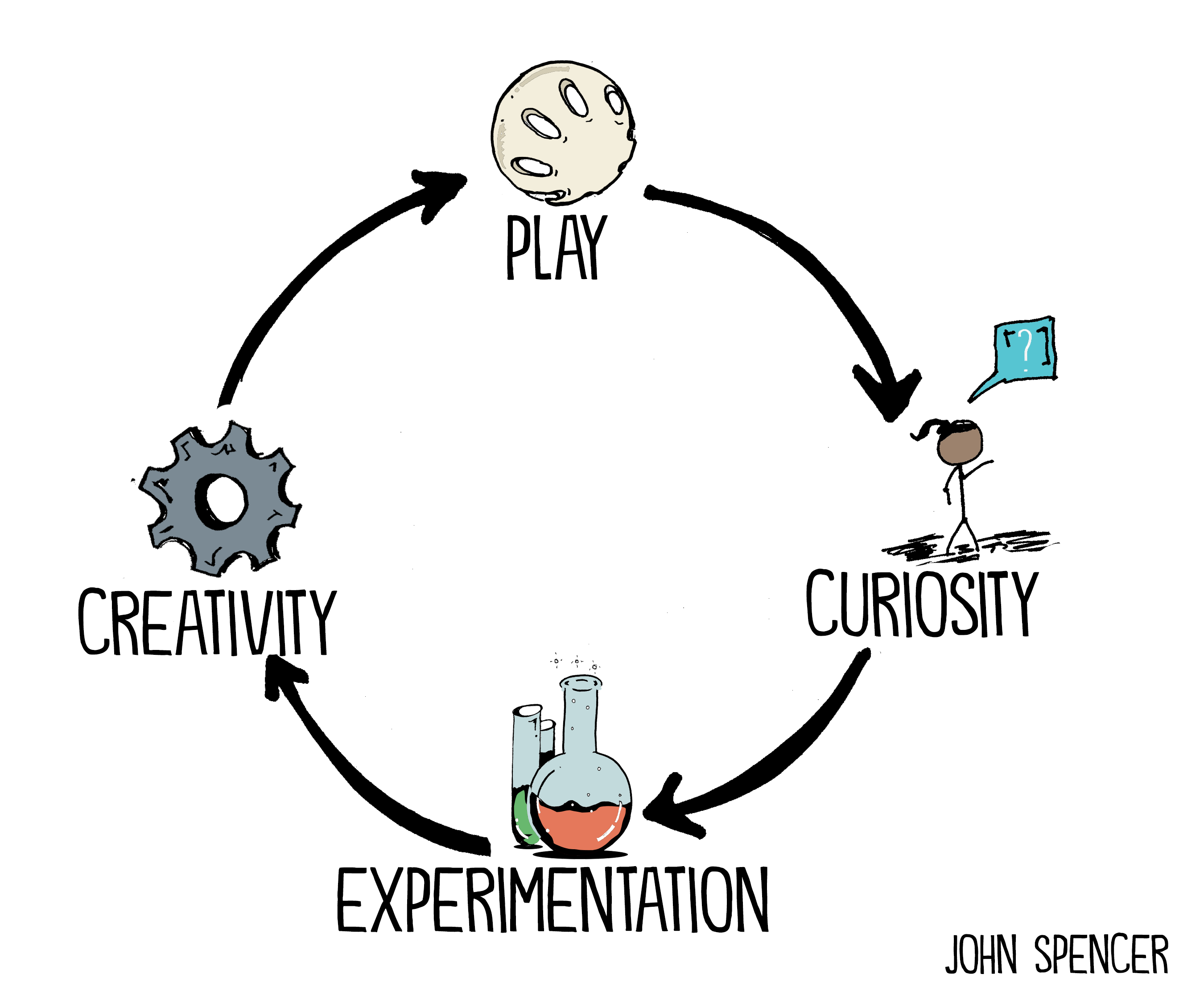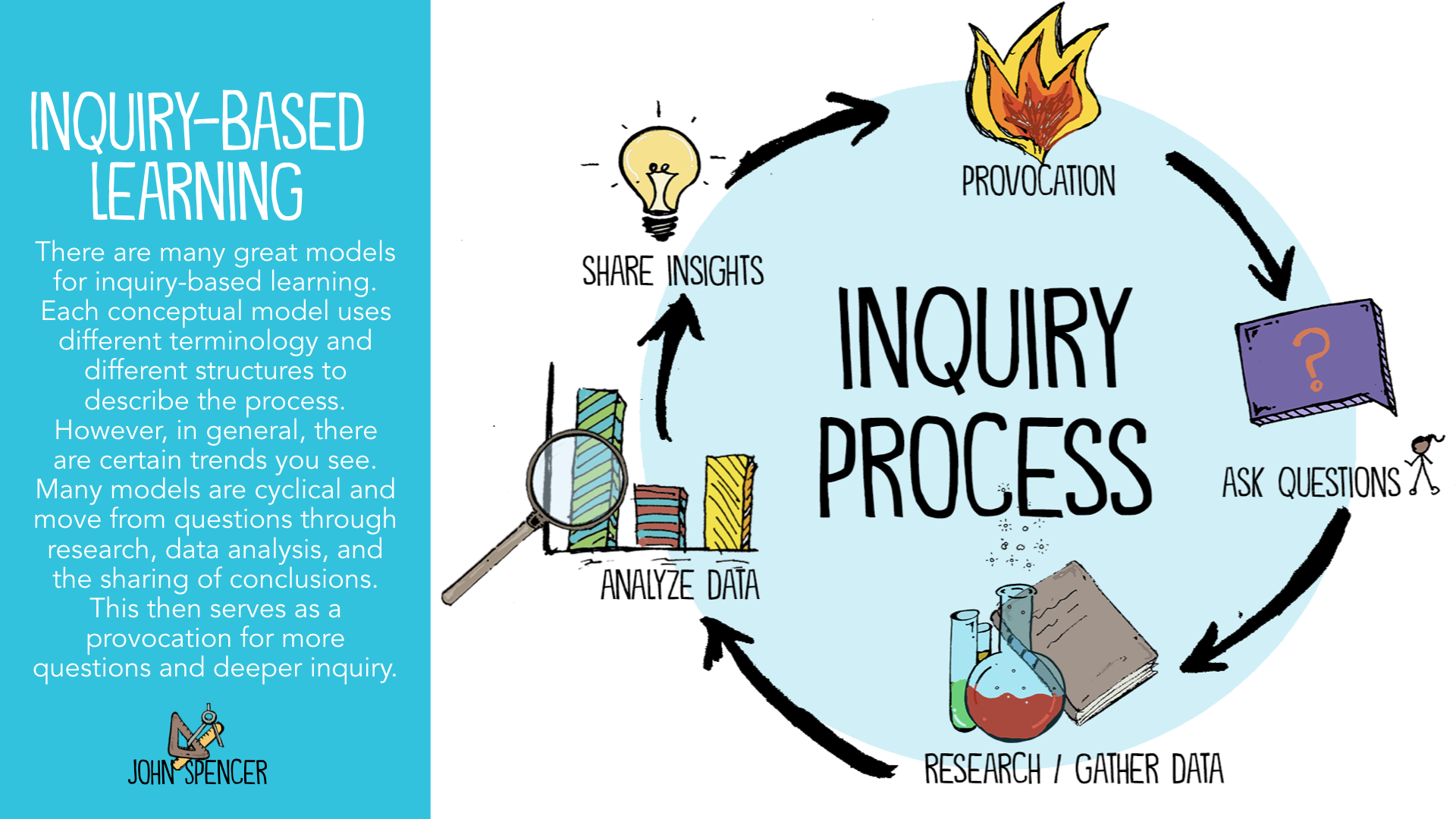Using a Wonder Day Project to Spark Student Inquiry
Education Rethink 2021-01-19
My friend George Couros once said, “If students leave school less curious than when they have started, we have failed them.” I tend to agree. I’ve never heard of a cosmologist who says, “I’m done with the universe. No more questions here.” I’ve also never seen an engineer who says, “I’m an expert now. I really don’t need to figure out how stuff works.” Nor have I seen any historians who say, “I don’t really care what happened in the past.” Novelists tend to have stacks of books that they want to read. Even the most seasoned chefs are always out searching for new cuisine (see what I did there). Marathon runners are always trying to figure out ways to improve their approach.
In other words, learning should make you more curious. In fact, there’s often an ongoing cycle of curiosity and creativity, often inspired by play.
 Unfortunately, it doesn’t always work this way in traditional schooling where the system tends to place a high premium on getting the right answer — and getting it quickly. In the process, students internalize the message that uncertainty is a sign of failure and that wonder and amazement are something you can experience in rare bursts. But with inquiry-driven PBL, students are able to tap into that curiosity, engage in research, and ultimately create a product for an authentic audience. In the process, you begin to transform the classroom into a culture of inquiry.
Unfortunately, it doesn’t always work this way in traditional schooling where the system tends to place a high premium on getting the right answer — and getting it quickly. In the process, students internalize the message that uncertainty is a sign of failure and that wonder and amazement are something you can experience in rare bursts. But with inquiry-driven PBL, students are able to tap into that curiosity, engage in research, and ultimately create a product for an authentic audience. In the process, you begin to transform the classroom into a culture of inquiry.

An Epic Example
In The Order of Phoenix, the fifth of the Harry Potter series, Dolorus Umbridge takes over as the Defense Against the Dark Arts teacher and instantly transforms the class into a textbook-based class focused on passing the standardized tests. When Harry questions whether this will prepare them for the chaos of fighting against Vold . . . err . . . um . . . he who must not be named . . . Umbridge punishes him and he ends up forming his own school within a school called Dumbledore’s Army.
Dumbledore’s Army is purely inquiry-based. While Harry is the teacher, he is mostly a guide on the side, empowering the students to ask questions and find the answers themselves. They rely on each other and on various spell books to solve problems and answer their questions. While the process might seem messy compared to Umbridge’s approach, the students learn at a rapid pace because they aren’t wasting time repeating what they already know.
This is an example of inquiry-based learning.
What Do We Mean By Student Inquiry?
The inquiry-centered approach has existed for thousands of years. Socrates and Confucius both used variations on this format. It’s a critical component of the scientific method of the early enlightenment and it was a core idea within both Dewey and Montessori’s notions of student-centered learning.
Margus Pedaste shares a model of the four phases of inquiry. It starts with orientation, which is often a discussion. From there, it moves into conceptualization, where students generate questions and define a hypothesis. This leads to investigation, where students explore, experiment, and interpret data, often in a way that is flexible and dynamic. Finally, they move to a conclusion.
The key idea is that students start with curiosity, engage in their own research, and analyze what they find in order to reach a conclusion. However, sometimes they need a little help along the way. Heather Banchi and Randy Bell define four different types of inquiry that you can view on a spectrum from teacher-centered / structured to learner-centered / open.
- Level 1 is Confirmation Inquiry, where the teacher teaches the concepts, creates the questions, and models the process for students.
- Level 2: is Structured Inquiry, where the teacher creates the initial questions and shares the procedures then walk through the rest of the inquiry process by collecting and analyzing data and drawing conclusions.
- Level 3 is Guided Inquiry, where the teacher provides the research questions but students own the research or experimentation process.
- Level 4 is Open/True Inquiry. Here students formulate their own questions, design their own experiments or research, collect their own data, and share their findings.
According to Banchi and Bell, teachers should start with levels 1 and 2 and use those as scaffolding, so that students can learn the inquiry process. However, in my experience, there is power in asking students to engage in Level 4 inquiry, where they are truly empowered to ask their own questions and engage in their own research.
Inquiry-Driven PBL
Note that inquiry-based learning does not always require project-based learning. An inquiry-based lesson could be a short exploration or a scientific experiment. It could be a complex math problem based on a scenario. However, there is a lot of overlap between project-based learning and this process of exploring, experimenting (or researching), interpreting data, and reaching a conclusion. Here’s where students can engage in inquiry-driven PBL. The following sketch is a general picture of what inquiry-driven PBL looks like:
 With Inquiry-driven PBL, students start with their own questions. As a teacher, you might provide an open-ended prompt of “what are you curious about?” or “what question would you want to explore if that were an option.” Other times, you might show a picture that piques their interest or narrow it down to a topic like, “We’re learning about the Civil Rights Movement. What types of questions do you have about this topic that you would want to explore on your own?”
With Inquiry-driven PBL, students start with their own questions. As a teacher, you might provide an open-ended prompt of “what are you curious about?” or “what question would you want to explore if that were an option.” Other times, you might show a picture that piques their interest or narrow it down to a topic like, “We’re learning about the Civil Rights Movement. What types of questions do you have about this topic that you would want to explore on your own?”
From there, students engage in research. In a science or math class, this might look more like experimentation or data collection. In a language arts or social studies class, this might involve doing online research or interviewing an expert. But it’s critical that students see the research process as flexible and open. I learned the hard way that too much scaffolding can be cumbersome. What I had designed as a scaffold felt like a cage to students who didn’t need the help.
Afterward, students get the chance to analyze their information and determine how they will share their findings. At this point, they will work on a quick period of brainstorming as they figure out what type of product they will create to share their findings. Students might create a Q&A blog post or a podcast explaining their research process. In this case, the final product is a chance to share their share their journey with an audience.
Other times, this inquiry process leads to a larger product, where they synthesize their information into a documentary or a podcast series. In some cases, the inquiry and research might lead to a creative breakthrough, where students decide to design a solution to a specific problem. But the idea remains the same — that through asking questions and engaging in research, students are then able to create a product that they share with an audience.
So, what does this actually look like in action?
In a language arts classroom, you might focus more on specific research-related skills as students work through an open-ended inquiry project like the Wonder Week project (see below). Or you might have students create their own blogs where they work through one specific topics and use this inquiry-driven approach to create new content. In social studies, it might be a two-day exploration of whatever geeky questions students have about the particular theme or concepts you are exploring. Or it might be the start of a larger documentary project or student podcast series. In math, you can have students explore a concept and develop their own problems in the “What can you do with this?” approach that Dan Meyer developed. In science, you could do a science fair project or a myth-buster style approach to testing an urban legend.
If we want students to own their learning, we need them to remain curious. And this is why inquiry-driven PBL is so powerful. They get to make the connection between curiosity and creativity.
Try a Wonder Day or Wonder Week Project
If you’d like to try out inquiry-driven PBL but you aren’t entirely sure where to start, you might want to check out the free Wonder Day or Wonder Week Project. This project begins with open-ended student inquiry, where they get to choose the topic and the questions. However, it aligns to content-neutral skill standards that cover many of the informational reading, research, and digital content creation standards found within the Common Core ELA standards.
Here’s the prompt you can use with students:
Time Required: Single Day or Full Week
Materials Required: This project works best when they can do online research.
Description: This is a fun, easy way to get students engaged in non-fiction reading. I use it as a high-interest way to help students learn the research process. Students begin with the sentence stem, “I’m wondering why/what would/how/if __________” and from there they ask tons of questions. This ultimately leads to research and finally a place where they share what they learned.
Day 1: Choose a topic, ask questions
Days 2-4: Engage in research and analysis
Day 5: Create a final digital product sharing your findings and send it to an authentic audience.
Note that this is a great starting point for a larger Genius Hour project or a new design thinking project where they will begin to build empathy with an audience and work through a longer process. However, it can also work well as a single, stand-alone project on the last week before a break or the week of testing (when things are chaotic and disruptive).
If you’re interested in the Wonder Day and Wonder Week Project, sign up below:

Please leave your email address below and click the yellow subscribe button to receive the free inquiry-based Wonder Day / Wonder Week project. It includes the process and the handout you can use with students. I will also send you a weekly email with free, members-only access to my latest blog posts, videos, podcasts and resources to help you boost creativity and spark innovation in your classroom.
Success! Now check your email to confirm your subscription.
There was an error submitting your subscription. Please try again.
The post Using a Wonder Day Project to Spark Student Inquiry appeared first on John Spencer.